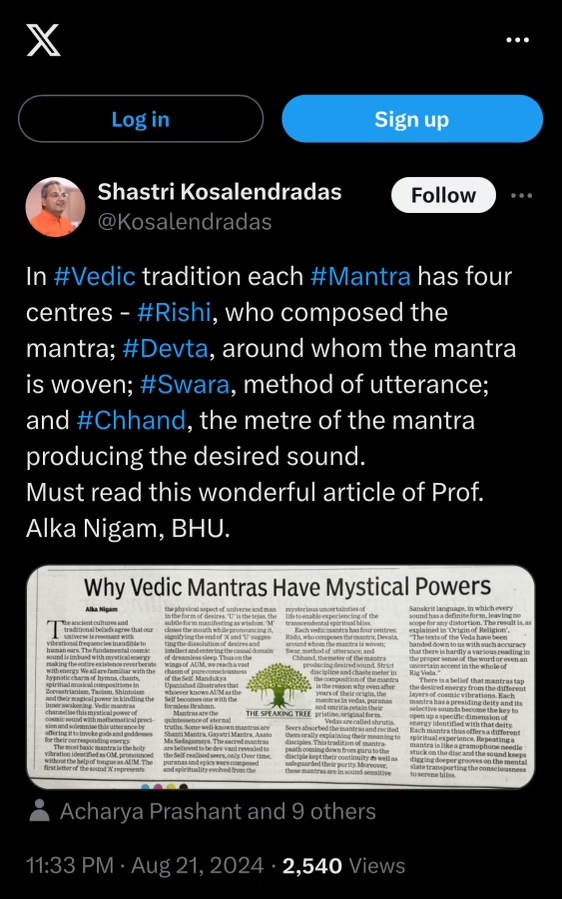Published in The Speaking Tree, page 4 (print edition), dated Nov 18, 2018
https://www.speakingtree.in/article/a-drop-reveals-the-ocean
ALKA NIGAM writes of an eight-year-old Adi Shankara’s six-verse poem, the Atma Shatakam that encapsulates Advaita philosophy
Shankara’s short poem consisting of six melodious lyrics is a magical gem radiating with the entire divine spectrum of Advaita Vedanta. It is said that when Shankara was eight years old, he was roaming on the banks of the Narmada in search of a guru. There he met Swami Govind Bhagwatpada who asked him, ‘Who are you?’ In reply to the question, he recited these six shlokas known as Atma Shatakam. The extraordinarily talented boy said to be the incarnation of Shankara, later became Adi Shankaracharya who revived a moribund Hinduism by unifying diverse scattered thoughts into Vedantic one ‘One Truth Many Expressions’. His Atma Shatakam is not only a reply to his guru’s question ‘Who are you’ but an eternal reply to every man’s quest for nirvana and lasting peace.
Most of us remain ignorant of our raison d’etre on this planet and are happy in the octopus grip of maya till we die. In a new body we continue with the same pleasure games and the cycle thus continues. The only realisation that we are not only the body but have a soul too, saves us and we get into our real nature — eternal bliss.
Atma Shatakam opens and continues till the five stanzas dismiss all the activities associated with our body, mind and heart. The energy of our prana flows through the seven levels around the seven chakras embedded in the spinal chord of the human body. We are usually involved with three levels of karmas. At the lowest, gross level are those of the body — sense organs and the pleasures they give. The activities at the mental level are linked with our intellectual capabilities. When the needs of the body are satisfied, we start asking questions about our destiny, the purpose of life, our surroundings and fellow beings. Only when we come out of our own shell do we go to a higher level of being.
The third level of our karmas springs from our heart. Our feelings of love, compassion, empathy and resulting experiences of peace and joy take us to the highest level of karma. We break the boundaries of our small self and reach out to others. Still these karmas and their fountainhead from where they spring are linked directly or indirectly with our ‘I’ or ego, hence are denounced by Shankaracharya. He names them all — virtues, vices, ambitions, fears, and all types of bondage — as chains. No matter whether they are made of gold or iron, chains are nonetheless chains.
The fourth line of all the five stanzas is one bold statement running throughout the body of the poem. It is the thread that holds the pearls of this holy necklace. It says — I am the eternal bliss because I am Shiva — and a repetition of the phrase ‘I am Shiva’ like a sledgehammer lays more emphasis again.After various exclusions, this statement in each stanza emerges as an inclusion because it makes a connection between our soul and the Supreme Soul, which is missing in the karmas, proclaimed worldly, therefore, unworthy by Shankaracharya.
Just like in the broken groove of a music record some lines of a song get entangled, the nectar from the recurring Shivoham Shivoham trickles deep down consciousness and its echo lingers on long after the poem is over.It helps in settling down restlessness and we feel a blissful calm. No wonder the poem is also known as Nirvana Shatakam. The sixth quatrain celebrates the magic of a liberated soul. Transcending the body is like breaking down its walls. Once out of body, consciousness experiences the freedom of formlessness and becomes one with Universal Consciousness. This ends all dualism.
Go beyond the boundaries of this body, let go of your ego and the merger will happen. Let prana energy flow with the current to the seventh chakra and the immersing of oneself in the indissoluble union with the True Self becomes possible. This is the ultimate assimilation of the jiva with the ultimate metaphysical reality.
This gripping short poem is a remarkable consolidation of the doctrine of Advaita Vedanta. It holds the vast ocean of deep, liberating philosophy in a tiny drop.

Leave a Reply